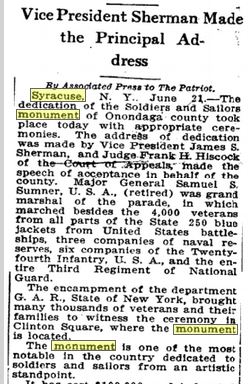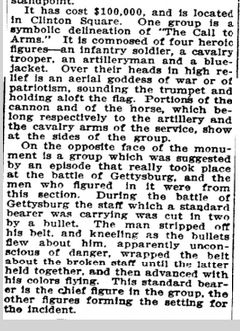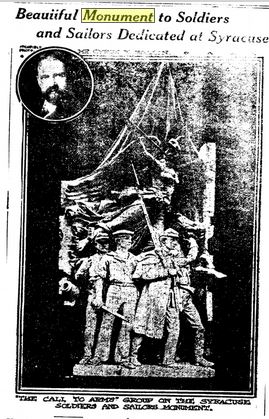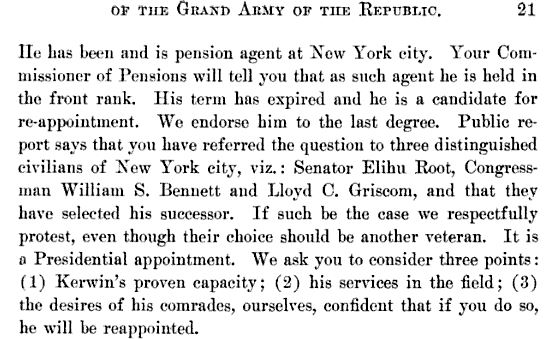Pennsylvania Connections to the Syracuse (NY) Soldiers’ Monument
Posted By Norman Gasbarro on January 8, 2014
Normally, I try to research all inquiries received from readers of the blog, regardless of how far afield they at first may appear to be. Usually, I am successful in making at least one connection with the goals of the Civil War Research Project. In the case of the inquiry I am about to describe, I found two interesting connections.
In an e-mail dated 22 December 2013, Glenda wrote:
My mother recently passed away and a few G.A.R. items were found. Is this medal related to the info on your site? It has Syracuse rather than Atlantic City on it but I was just researching some of the items and found you. Any info would be appreciated. Thanks.
The above picture of a G.A.R. medal and ribbon was attached to the e-mail. It was a medal issued in June 1910 for the dedication of the Soldiers’ and Sailors’ Monument of Onodaga County, New York. The inscription on the medal notes the 44th Annual Encampment of the G.A.R. Department of New York. In researching the 1910 encampment date as the 44th , Glenda found my blog post on the 44th G.A.R. Encampment in Atlantic City which featured the national encampment and memorabilia associated with it. The medal pictured above was from the New York state encampment, which in 1910 was held in Syracuse, New York. In addition to the annual national encampments, most states had their own annual encampments.
The monument, which is pictured on the medal, was dedicated in June 1910 as part of the festivities of the state encampment. An article appeared in the Harrisburg Patriot which described the dedication ceremony and monument itself – wherein the first Pennsylvania connection is revealed:
Vice President Sherman Made the Principal Address.
Syracuse, New York, 21 June 1910 — The dedication of the Soldiers’ and Sailors’ Monument of Onondaga County took place today with appropriate ceremonies. The address of dedication was made by Vice President James S. Sherman, and Judge Frank H. Hiscock of the Court of Appeals, made the speech of acceptance in behalf of the county. Major General Samuel S. Sumner, U.S.A., (retired) was grand marshal of the parade, in which marched besides the 4,000 veterans from all parts of the State 250 blue jackets from United States battleships, three companies of the Twenty-fourth Infantry, U.S.A., and the entire Third Regiment of National Guard.
The encampment of the Department G.A.R., State of New York, brought many thousands of veterans and their families to witness the ceremony in Clinton Square, where the monument is located.
The monument is one of the most notable in the country dedicated to soldiers and sailors from an artistic standpoint.
It has cost $100,000 and is located in Clinton Square. One group is a symbolic delineation of “The Call to Arms.” It is composed of four heroic figures – an infantry soldier, a cavalry trooper, an artilleryman, and a blue jacket. Over their heads in high relief is an aerial goddess of war or of patriotism, sounding the trumpet and holding aloft the flag. Portions of the cannon and of the horse which belong respectively to the artillery and cavalry arms of the service, show as the sides of the group.
On the opposite face of the monument is a group which was suggested by an episode that really took place at the Battle of Gettysburg, and the men who figured in it were from this section. During the Battle of Gettysburg the staff which a standard bearer was carrying was cut in two by a bullet. The man stripped of his belt, and kneeling as the bullets flew about him, apparently unconscious of danger, wrapped the belt about the broken staff until the latter held together, and then advanced with his colors flying. This standard bearer is the chief figure in the group, the other figure forming the setting for the incident.
The picture featured with the article is shown below:
The second Pennsylvania connection was revealed through additional research on one of the issues that was discussed and promoted at the Syracuse encampment. In a book entitled Abstract of General Orders and Proceedings (1911), a letter was reproduced which was sent to President William H. Taft, urging the re-appointment of Michael Kerwin as Pension Commissioner for New York. Michael Kerwin was an official of the New York G.A.R. and his term was about to expire and a presidential re-appointment was needed to keep him in office. The political patronage controversy, apparently involving a U.S. Senator and representatives, is described below in a letter supporting Kerwin’s re-appointment.

Michael Kerwin (1837-1912)
Who was Michael Kerwin? According to on-line information, Kerwin was born in Wexford, Ireland on 15 August 1837 and emigrated to Philadelphia with his family around 1847. When the Civil War broke out, he joined the 24th Pennsylvania Infantry, Company H, as a 1st Sergeant and served a full 3-month term with that regiment before re-enlisting as Captain of the 13th Pennsylvania Cavalry, in which he served the remainder of the war, rising to the rank of Colonel of the regiment. Many men of the Lykens Valley area served under his command. His honorable discharge occurred on 14 July 1865. Col. Kerwin’s distinguished record has been described by Damian Shields in the blog post, Irish Colonels – Michael Kerwin, 13th Pennsylvania Cavalry. After the Civil War, Michael Kerwin returned to Ireland for a time and then moved to New York City, which is where he lived until his death on 20 June 1912.
Another story about Michael Kerwin appears on the Findagrave post featuring his stone Arlington National Cemetery.
Thus, what seemingly was a New York State G.A.R. commemorative medal, with a little research proved to have two Pennsylvania connections – one of Gettysburg, in distance not far from the Lykens Valley, and the other of the Colonel of the 13th Pennsylvania Cavalry – who served as the commander of many men from the Lykens Valley area.
—————————–
News clippings are from the on-line resources of the Free Library of Philadelphia. The excerpts from the G.A.R. proceedings are from a GoogleBooks version available as a free download.
 ;
;








Comments